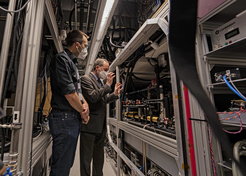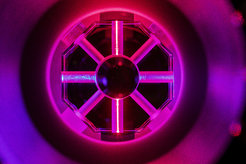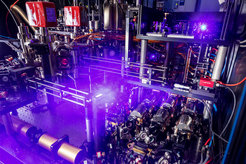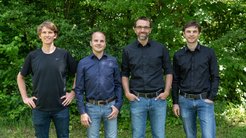How Munich-based start-up planqc wants to be the first to build quantum computers with thousands of qubits
Article by Wolfgang Kerler, 1E9
Can a start-up stand a chance against Google or IBM in the race for operable quantum computers? It certainly can, because so far it is not even clear which technology platform will prevail, and planqc from Munich is pursuing a different path than the tech giants. It relies on neutral atoms, lasers, microscopes and decades of research at the Max Planck Institute for Quantum Optics.

If you follow Sebastian Blatt through the winding corridors of the Max Planck Institute of Quantum Optics (MPQ) in Garching near Munich, you will not only lose your bearings. You will also see what progress science has made in the past few years. Even as a layman. With every generation, the quantum simulations that are constructed here with lasers, microscopes and many optical fibres are shrinking.
The machine, which quantum physicist Blatt has been setting up with his team since 2015, spreads over three large laboratory tables. Newer experiments need just one table - and thus comes quite close to the quantum computer that Blatt and his three co-founders now seek to develop with their start-up planqc.
"Over the last few decades, people in science have found that building a quantum computer is a very long project," Blatt tells 1E9. "But we believe that we have now reached a threshold from which it really becomes possible." He is chief technology officer at planqc while at the same time continues to lead research at MPQ.

For a long time, the focus there was not on developing computers at all, but on simulating quantum systems. At MPQ, several generations of researchers wanted and still want to find out how constellations of many quantum particles, i.e. atoms, ions, electrons, protons, actually behave. Because by far not all scientific questions about the quantum world have been answered.
"We simply wanted to gain a better understanding of physics," says Sebastian Blatt. "But systems with many quantum particles cannot be simulated on classical computers. Even the best supercomputers in the world can handle maybe 30 or 40 particles." How to get around this problem? "You simply recreate the quantum systems in analogue simulations, which themselves consist of many quantum particles, and observe what happens."
Simple, however, is not to be taken literally here, because the development of quantum simulators is highly complex and has been ongoing at the MPQ for many years. During this process, the institute achieved breakthroughs in the construction of lasers and of quantum gas microscopes that will now form the basis for planqc's quantum computers – a promising by-product to basic research. "We have learned so much in the meantime that we are now able to say: OK, let’s use them to make qubits," says Blatt.
Neutral atoms become qubits for the quantum computer
The basic principles of the existing quantum simulators at MPQ and the future planqc quantum computer are similar: an element, for example the metal strontium, is heavily heated in a furnace so that an atomic beam emerges. With electromagnetic fields and lasers the researchers can slow down the neutral atoms in the beam and trap them in a vacuum chamber in specific places. There, the researchers can observe the atoms with special quantum gas microscopes and in turn manipulate them individually with laser beams sent through the microscopes, for example by putting them into an excited state with the energy of the laser.

Through this microscopic control individual atoms can be entangled with each other and quantum algorithms can be executed. The neutral atoms, which are quantum particles, thus function as qubits in the planned planqc processors and take over the computing tasks. Unlike the bits in classical processors or the qubits in the quantum computers from IBM or Google, they are not located on a chip, but in a vacuum in the middle of a specially processed glass object fitted with mirrors. This optical resonator will form the heart of the planqc quantum processor.
To address qubits with lasers and to read them out they must be sorted into an initially two-dimensional grid structure, increasing to a three-dimensional grid with the number of qubits. "That is a challenge," says Sebastian Blatt. "But one we basically have solved." Scaling up to thousands or even millions of qubits, which are probably needed to build a commercially viable quantum computer, remains challenging even with this approach, but may be easier than for competitors relying on other technologies.
Superconductors versus ion traps versus neutral atoms
In the development of quantum computers, various research approaches have been pursued for years – all with their own advantages and disadvantages. Planqc, as just explained, relies on neutral atoms as qubits that can be manipulated by laser and microscope in a vacuum.
In contrast, the American technology companies IBM and Google, but also the European quantum computer manufacturer IQM, produce computers that use superconducting circuits on chips. These have to be cooled down to almost zero at great expense. At the moment, this technology is considered leading, but Sebastian Blatt believes the quantum optical approach with neutral atoms from planqc to be more promising in the long run.

"For one thing, our system can be operated at room temperature," he says. "For another, the superconducting circuits are facing the problem that on the solid-state chip every quantum particle is a bit different, whereas with us every atom is the same from the ground up." As a consequence, he says, superconductor technology is more prone to errors. Scaling up from the current 100 qubits to thousands or millions of qubits, therefore, is extremely costly.
According to Sebastian Blatt, the latter also applies to another technology: quantum computers with ion traps. In these, electrically charged atoms, which are held in a vacuum by electromagnetic fields, form the qubits. But ions, i.e. electrically charged atoms, repel each other. A problem that does not exist with the neutral atoms of planqc, says Blatt.
"With current quantum computers, you can only solve theoretical, scientific tasks," he says, "if at all. To work on industrially relevant problems, we need at least a few hundred fully controlled qubits, if not a few thousand. And we think we'll be able to do that particularly well." However, he admits that at the moment no one can foresee which technology platform will prevail in ten, 20 or 30 years.
planqc has already secured 4.6 million euros
Because even planqc has not yet answered all the open questions. The biggest challenge is the precise "spotlighting" of the individual qubits by laser. "The quantum computer requires that the atoms, i.e. the qubits, are very close to each other," explains Sebastian Blatt. So close, in fact, that it is at the limit of what is physically possible to focus a sharply defined laser beam precisely on a qubit. But if the light hits a neighbouring qubit at its edges, there is a crosstalk between the atoms – which in turn produces errors.
The founders of planqc

"We have already solved the problem under laboratory conditions," says Blatt. "With our start-up, we now want to make these solutions smaller and cheaper and commercialise them." The financing to build a demonstration plant has already been secured by planqc: at the end of June, the start-up was able to announce a financing round of 4.6 million euros, led by investors UVC Partners and Speedinvest. In "three, four, maybe even five years" there will be the first planqc quantum computer, says Sebastian Blatt.
And then how does the start-up plan to earn its money? On the one hand, through the sale and delivery of quantum computers, and on the other hand, through cloud access to quantum computers that planqc operates itself. Incidentally, these should end up looking somewhat less spectacular than the current computers from IBM or Google, which look a bit like chandeliers when undisguised, and also than the laboratory experiments at MPQ with their many cables and lasers. They are housed in standard server cabinets that are unlikely to be too eye-catching in data centres.
This article is authored by Wolfgang Kerler from 1E9, and translated at MPQ. Original Source: https://1e9.community/t/so-will-das-muenchner-start-up-planqc-als-erstes-quantencomputer-mit-tausenden-qubits-bauen/17851
















